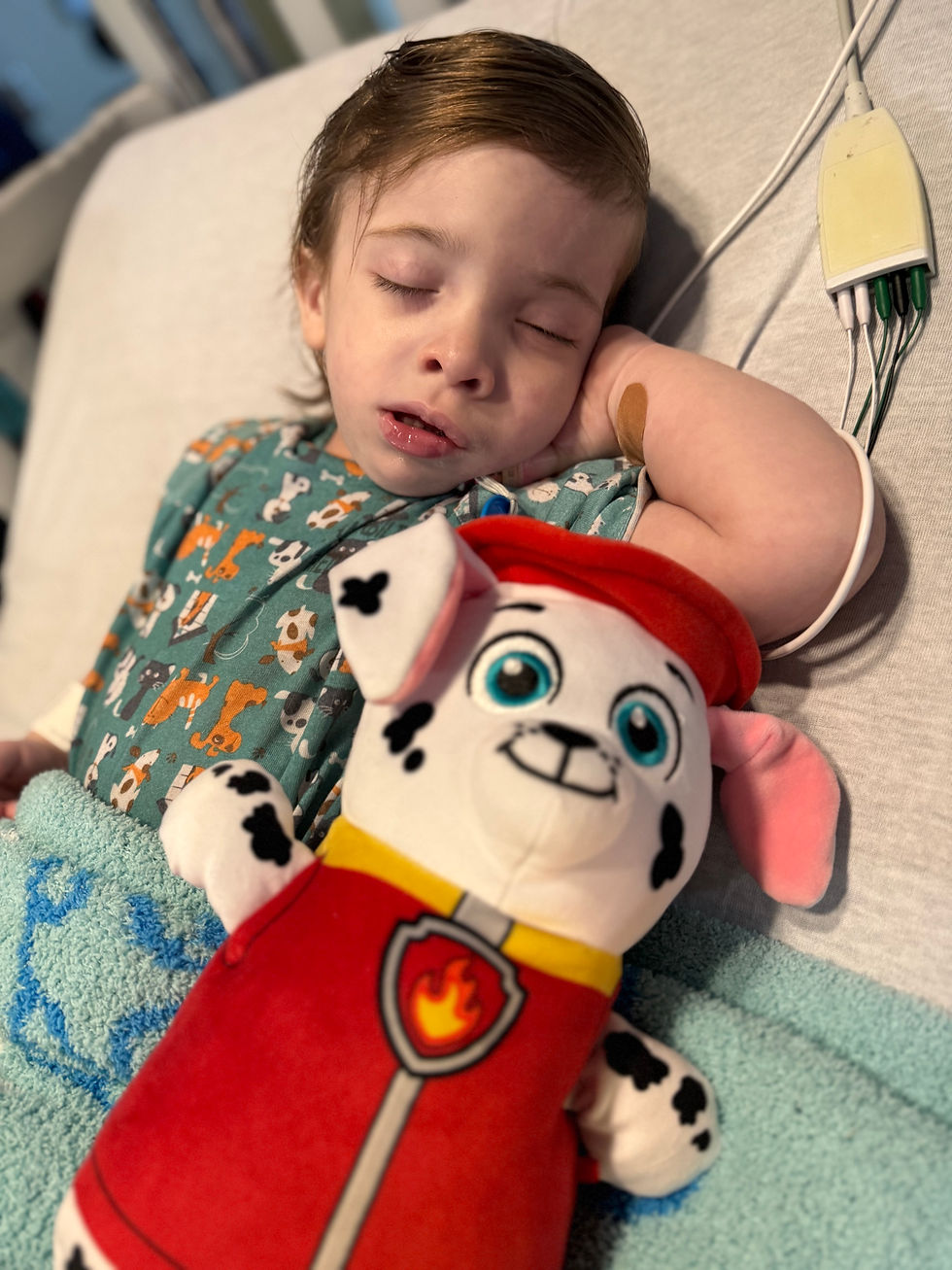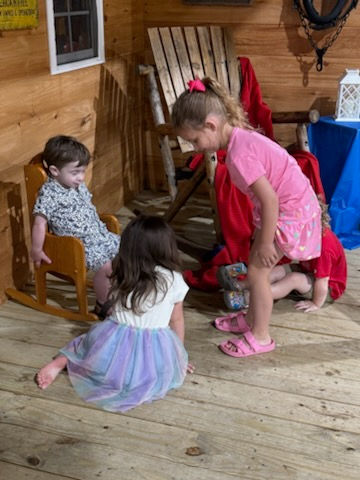Trusting your intuition
- Brittany Jackson
- May 23
- 7 min read
It's been three weeks since Elliot's Chiari decompression surgery. I feel like we are just getting back to a sense of normalcy. I want to take the time to share our experience with this surgery and the recovery, just in case someone reading this blog is in our shoes.
If you have a rare disease, or if you are the parent of a child with a rare disease, you end up getting comfortable with the answer "we don't know" or "we can't be sure." As far as I know, there are no doctor's that specifically specialize in Elliot's condition. The research is lacking and the treatment is more supportive than anything else. There is no cure. Leading up to his Chiari decompression, Jack and I contemplated about whether this was the right choice for Elliot. Elliot's neurosurgeon initially felt that the Chiari wasn't needed. He felt that it was so mild in presentation that it couldn't possibly be the cause of his syrinxes that had developed. He was confident that his tethered cord was much more likely to have been causing the obstruction of the CSF resulting in those syrinxes. Unfortunately, revision of the tethered cord didn't resolve these issues.
When we got the results of his second brain and spine MRI, we found out the syrinxes had grown in size. Both of us and the neurosurgeon still questioned whether the syrinxes and Chiari were actually manifesting in neurological symptoms or not. It's very hard to determine this with a young child who can't communicate. Symptoms we'd be looking for included, headaches, neck pain, dizziness/balance problems, poor coordination, muscle weakness, numbness and tingling in arms/legs, difficulties swallowing, speech problems, hoarse voice, and sleep apnea. Elliot has many of these issues, but unfortunately many of these issues could also be contributed to his other health issues and MCAP itself. The neurosurgeon couldn't tell us definitively whether Chiari decompression would resolve these issues. So we were left to deciding about a procedure that may or may not benefit Elliot at this time. Ultimately, we decided to move forward as we felt this was the best chance of treating the spinal syrinxes. We knew that if these continue to grow we'd be looking at more serious neurological deficits because almost the entirety of his spinal cord was affected by syrinxes (C4-T2, and T-5 to L3/L4), this left very few vertebral areas unaffected.
Day of surgery:
We arrived to Vanderbilt Children's hospital a little before our scheduled 6 am arrival time. Because we were the first surgery of the day, things moved fairly quickly. Elliot fell asleep right after we got settled into our pre-op area and stayed asleep as they wheeled him back.

We were told to expect the procedure to last about 3 hours, and it ended up only lasting about 2 hours. The surgeon updated us that he utilized three methods to reduce the obstruction of CSF flow- removal of a portion of the skull cap and added a flexible graft, removal of a portion of his C1 bone, and cauterization of the cerebellar tonsil that had extended into the spinal cavity. At the end of the procedure he told us he was able to completely visualize the path into the fourth ventricle, which meant flow was no longer obstructed. After a brief period in recovery, Elliot was moved to a pediatric ICU for frequent neurological monitoring. The first 24 hours after surgery, Elliot did really well. He definitely wasn't active but wasn't as lethargic as I'd expected either. They utilized a mix of an opioid medication and valium for his pain management in the ICU. The valium specifically was being used to reduce the likelihood of muscle spasms in the neck.

Day after surgery:
We were moved to a regular room right at about 24 hours after surgery. Elliot seemed to do well the first 5-6 hours we were in this room. He was transitioned off the opioid and valium and started on Tylenol for pain management. That evening, Elliot vomited for the first time. We were assured that this can be common during recovery from Chiari decompression, so we didn't think much more about it. He went to sleep not long afterwards.

Discharge day (day 2 post-surgery):
Elliot had a little more nausea and vomiting on Sunday morning, but was keeping most of his intake down. His team felt he was doing well enough to go home a day early, as long as he could keep down his next bottle. They checked in after his last bottle, and he had kept it down, so they put in for discharge. Jack had packed up all our belongings and the nurse had gone over his discharge instructions. After that, I got Elliot dressed and the nurse removed his IV. While waiting on Jack, I stood up with Elliot to grab some things and he vomited all over me. I should have trusted my judgement then- I felt like we probably needed to stay. Instead we asked for them to amend the discharge orders and send in zofran as needed for him as well and we went home. The vomiting continued that evening, but he was able to keep some of his medication and clear liquids down. We set alarms for every 3 hours that night to rotate tylenol, motrin, and his zofran.

Day 3 after surgery:
Early Monday morning, we woke up Elliot for his Tylenol, and as Jack set him up he vomited. This time it wasn't formula, it was a reddish brown liquid. We knew then we had to go back to Vanderbilt. So we packed up our stuff into the truck, got Elliot loaded in, and headed back to Vandy at about 5 am. Elliot continued to vomit during the car ride. We headed straight for the ER and thankfully they got us right back to a room. The ER team was great. They called in their best IV nurse to do his IV, which we requested as he'd had many failed sticks between recent appointments and IV attempts for surgery. She placed his IV with the help of ultrasound and even used some numbing spray to help ease the pain for him. The quickly got us back for a CT and X-ray to rule out major complications from the surgery. After all major complications were ruled out, we were admitted and moved back up to our previous floor for management. The goal was to get IV fluids, treat the nausea, and hopefully get him eating again. Elliot remained very lethargic that day, and within that 24 hour period he probably slept 20-21 hours of it.
Day 4 after surgery:
Day 4 started similar to day 3, with nausea and vomiting. We had a team of doctors following him and their goal continued to be the same. Around lunch time that day, I began to notice a trend with his vomiting- it almost always occurred after positional changes. After discussing it with Jack, and he agreed, we brought it up to his nurse and requested to speak with the team about possible vertigo. I realized that all of the vomiting started about the time his valium was no longer in his system as well, which could have been unknowingly keeping him from experiencing vertigo while in the PICU. His hospitalist/pediatrician agreed that vertigo was possible and we discussed treatment options. He was given a scopolamine patch, and literally within about 2 hours of getting the patch he was waking up, interested in food, and eating again. From that point, he was able to keep down about 80% of what he ate/drank the rest of that day. His team felt confident if this continued, that he'd be discharged the following day. I had to return to work the next day, so Jack stayed with Elliot that night and I returned home.

Day 5 after surgery:
Elliot was discharged around midday and Jack and him made it home by mid-afternoon. Unfortunately, it seems like Elliot has now developed motion sickness, and got sick not long before they made it back to Kentucky. Hopefully, this motion sickness is just a transient side effect from the surgery as we travel a lot for appointments. Elliot ate/drank okay the rest of this day, but continues to be pretty lethargic. He still wasn't moving much and wasn't talking or walking at all.
Day 6 after surgery:
This was the day that we feel Elliot finally started to turn a corner. I came downstairs from my office around 2-3pm and for the first time since surgery, Elliot sat up and smiled at me. He began to talk again and attempted walking around. He still was very off balance and required us holding him to stay balanced while walking.
Day 7 and beyond:
Elliot has continued to improve since this day. He is nearly back to his old self. He is jabbering, talking, demanding snacks, and is generally back to his mischievous toddler self. Our main concern over the last couple weeks has been keeping his incisions clean and dry, and keeping him from scratching at them. This has proven to be more difficult than expected. Thankfully, his neurosurgery team approved us using non-occlusive bandages at night, since this is when we noticed he was able to scratch at them.

Post Op Appointment:
We met with the PA on Elliot's neurosurgery team this past Monday. He was very happy with how Elliot is doing post surgery. He said his top incision looks amazing, and that the bottom incision still has some healing to do. He said this is pretty common because there is more movement in the neck which causes strain at the bottom incision site. He overall felt it looked good as well. He told us we'd be scheduled for a follow up MRI and neurosurgery appointment in 3 months.
Things I wish I knew before decompression surgery:
How lethargic Elliot was going to be, I don't think they really fully prepared us for this. For days he was merely a shell of a toddler. He had little to no interest in food/liquids, didn't talk or babble, and didn't have any interest in moving around. This was honestly the scariest part of his recovery.
To pack more clear liquid drink options. Elliot is still on thickened formula, and really didn't have much interest in it the first few days. The hospital had some clear liquid options, but not his preferred drinks.
How common vertigo is after this surgery and ways to help with the nausea and vomiting.
And, as much as I loved Elliot's mullet pre-surgery. I wish they would have encouraged us to go ahead and cut his hair. While they shaved the area they needed, the hair around it was long enough to get caught on his stitches and the bandages which caused Elliot some discomfort.




Comments